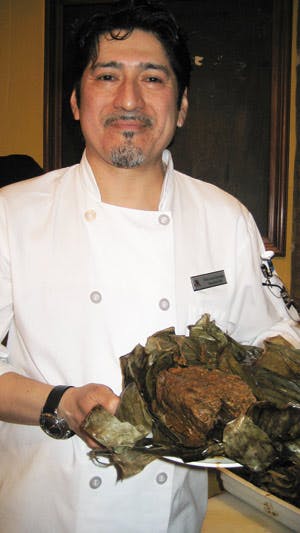Seminars, Programs Showcase U.S. Red Meat in the Greater Russia Region

Georgia’s growing tourism sector underlies the importance of educating chefs and foodservice professionals about U.S. beef and pork.
Efforts to increase U.S. beef and pork exports in the Greater Russia region continued in April with USMEF educational seminars in the Republic of Georgia. Funding support for these activities was provided by the Beef Checkoff Program, the Pork Checkoff and the USDA Market Access Program (MAP). A U.S. beef and veal workshop was also conducted for prospective hotel, restaurant and institutional (HRI) customers in Almaty, Kazakhstan, utilizing support from MAP and the Beef Checkoff Program.
One of the factors making Georgia an important market is that it features major Black Sea ports that make it a gateway to destinations in Central Asia. The Black Sea coast and Caucasus Mountains have also sparked significant growth in Georgia’s tourism and hospitality industries. Last year Georgia imported 16,423 metric tons (mt) of pork valued at $40.6 million. About half of this volume came from Brazil, but product was also imported from Canada and the EU. On the beef side, Georgia imported 7,805 mt valued at $22.3 million. Top suppliers were Brazil, India, Russia and the EU.
“In general, Georgian importers are not very familiar with U.S. meat and what we have to offer,” said Cheyenne Dixon, USMEF technical services manager. “So one of the primary purposes of our visit was to educate them about the benefits of U.S. meat products, especially the quality characteristics they are not accustomed to.”
To showcase the attributes of U.S. beef and pork, USMEF conducted educational meetings with Georgian and Armenian meat importers and distributors, as well as veterinary and customs officials. USMEF representative Liz Wunderlich spoke to attendees about the parallels between Georgia’s growing tourism sector and some of the emerging tourist destinations in the Caribbean, where she specializes in educating importers, restaurateurs, chefs and other foodservice professionals about the value and versatility U.S. beef and pork can deliver to their menus.
The USMEF team also visited Georgian meat processing facilities, retail and foodservice outlets that hold potential for U.S. meat. Dixon noted that while tariffs present a challenge in Georgia, the U.S. industry faces very few technical barriers.
“As far as technical issues are concerned, Georgia is wide open,” she said. “Our meetings made it clear that they are very receptive to importing U.S. meat.”
Galina Kochubeeva, a USMEF representative in the Greater Russia region, said Georgia currently imports a large volume of pork half carcasses, mainly from Brazil.
“With lower pork prices in the U.S. at the present time, the U.S. can certainly compete with the EU and Brazil,” she said. “We see potential for items such as bone-in and boneless hams, picnics and trimmings.”

A USMEF team visited Georgian meat processing facilities, retail and foodservice outlets that hold potential for U.S. meat.
The April meetings were the latest in a series of contacts with Georgian meat importers and industry professionals.
“Last year three Georgian companies participated in a regional buyers team that attended the USMEF Board of Directors Meeting and Product Showcase in Kansas City,” Kochubeeva explained. “We also trained Georgian chefs/restaurateurs at a workshop in Texas last year, where we provided education for importers, wholesalers and retailers.”
The goal of the Kazakhstan workshop was to showcase U.S. beef and veal, provide an overview of U.S. food safety programs and the USDA grading system and educate chefs and prospective buyers on proper handling and cutting techniques.
The event took part in the restaurant affiliated with “Kairat,” a popular local Kazakh football team. More than 40 chefs and restaurateurs participated.
“Kazakhstan hotels and restaurants, which use mainly frozen beef, chicken and lamb, are looking for more ways to feature chilled beef and veal,” Kochubeeva explained.
The goal of the Kazakhstan workshop was to showcase U.S. beef and veal and educate chefs and prospective buyers on proper handling and cutting techniques. Chef Paul De Visser, right, provided a beef and veal cooking demonstration.
Participants in the workshop, which USMEF jointly sponsored along with meat and seafood importer Alaska Seafood Kazakhstan and a local restaurant critics association, were shown high-quality beef cuts such as ribeye, tenderloin and striploin along with veal tenderloin, rack, short ribs and loin chops. A beef and veal cutting and cooking demonstration was conducted by Paul De Visser, executive chef at Maqan Hospitality in Almaty. A native of the Netherlands, De Visser shared his great experience working with U.S. beef at steakhouses in Europe and noted that veal is also very popular with his customers.
Though it is part of the customs union that includes Russia and Belarus, Kazakhstan has not supported Russia’s recent actions restricting U.S. meat imports and remains open to U.S. beef and veal. USMEF’s previous work in Kazakhstan includes two beef master classes at the Delaruk HRI show in Astana in 2012, where chefs displayed a strong interest in well-marbled U.S. beef. USMEF also took part in the World Food Almaty trade exhibitions in 2012 and 2014, and plans to participate in this event again in November.
